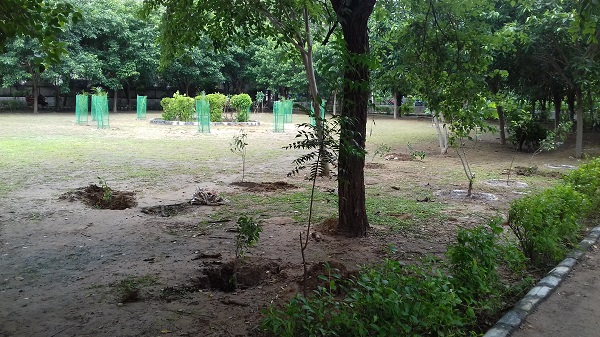Speaking on the subject of today's plantation drive in Dwarka, environmental experts concurred that Delhi government’s approach towards such drives belies a focus on quantity, not quality in addition to a lack of scientific methodology.

DWARKA - A plantation drive was organised by Delhi Government today at MCD Park, Sector 10, DDA Park, Sector 5 and various government schools in Dwarka. The teachers, children and other community members collectively planted around 1400 saplings of various types of trees and shrubs like peepal, neem, jamun, pilkhan (white fig) and other ficus species, mango, gudhal (hibiscus), kaner (yellow oleander) etc. during the drive.
Sanjeev Jain, a resident of Rajasthan Apartments, Sector 4 and president of Local Area Development Committee, Dwarka A and B, Matiala Assembly, said, “The response from the RWAs and social organisations was great and the community showed a lot of enthusiasm. We has begun our preparations ahead of time. At our request, the parks’ gardener had made arrangements for space for plantation according to the species of the saplings.”
Munish Kundra, a resident of Brahma Apartments, Sector 7, donated around 20 Mango, Jamun and Neem plants for the plantation drive. “This was a wonderful experience planting saplings with the children. I attended the drive at four different locations and immensely enjoyed every bit of it,” Kundra said.
Environmental activists and experts, however, while welcoming the move were also of the opinion that there were technical lapses in the plantation of some species. They said that a scientific approach towards plantation was lacking in the drive. They observed that the gap between the saplings of Ficus or trees like neem, jamun etc. was less than what it should have been. At the Sector 10 park the saplings were seen planted in close vicinity of each other. Some saplings of neem tree were also planted under fully grown trees.

Diwan Singh, a well-known environmental activist from the area, said, “Planting saplings in areas already lush with greenery is a little pointless. If the Delhi government is serious about plantation drives, it has to bring more land under green land use category and plant saplings there. The lands that are already under green land use category are already under sufficient vegetation coverage. This seems more like a move to make a fool out of people for the sake of gaining popular votes. Things like planting a tree under another tree happen when things are done merely to score brownie points.”
Singh, offering some positive criticism, said, “Firstly, instead of planting single species trees in a grove, diverse species should be planted next to each other as the former practice is bad for the ecology. Secondly, the space the saplings would need when they grow should not be ignored. For example, peepal tree saplings should be planted at least 20 feet away from each other.”
Some people also said that the local resident bodies and the authority representatives were not involved as the notice for plantation and coordination with the RWAs was not proper. President of Green Circle, a social organisation working in the field of environment in the area, V Selvarajan speaking on the subject said, “We are not in favour of quantitative but qualitative plantation. If neem trees were planted within one foot gaps, it is highly condemnable. Whoever organised such a plantation drive must be held accountable for their actions. We, from Green Circle, have been involved in tree plantation, re-erection of trees, fights against concretisation etc. for quite some time. We are disappointed that despite this we did not even receive a notice from any agency to get involved in the plantation.
Another environmental activist from the area and President of HIMAL, Ramesh Mumukshu, said, “Plantation drives wherein large numbers of trees are planted in a single area are not sustainable. It is strange that people planted trees under fully grown trees. That is akin to torture for the younger tree. Less number of trees planted in a proper manner is far better than bulk aimless plantation.”